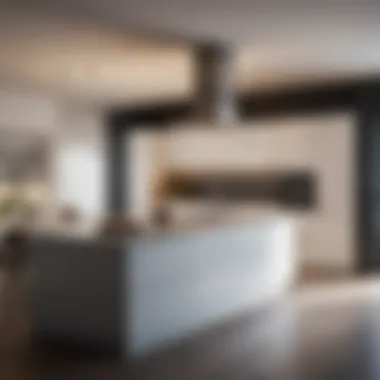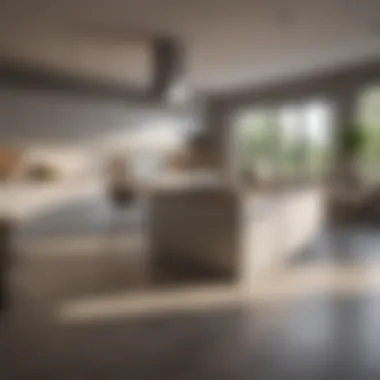Modern Minimal Kitchen Design: Principles and Trends


Intro
In the evolving world of interior design, kitchens hold a special significance. Gone are the days when they were merely functional spaces; now, they are the beating heart of the home. Modern minimal kitchen design draws upon simplicity and elegance, favoring a clean aesthetic coupled with high functionality. This approach is not just about smaller cabinets and less clutter; it embodies a deeper understanding of how personal style and practical needs can intertwine seamlessly.
The essence of modern minimalism revolves around creating a space that feels both luxurious and accessible. You don't need to fill every inch with ornate details to achieve beauty. Instead, the focus is on strategic choices—selecting materials, shapes, and colors that echo sophistication without overwhelming the senses. Whether you're a luxury travel curator or a fine dining consultant, understanding the nuances of this style can inspire not just kitchen layouts, but fresh ideas for enhancing lifestyle.
This article will peel back the layers of modern minimal kitchen design, illustrating its core principles, space considerations, and the array of materials at your disposal. We'll touch on the intersection of technology and sustainability, guiding you on how to integrate cutting-edge features while maintaining an eco-conscious ethos. Moreover, we'll explore the personalization opportunities within this realm, ensuring that your kitchen not only reflects elegance but also resonates with your unique taste.
As we embark on this exploration, you'll uncover practical insights and tips, allowing you to translate the minimalist philosophy into a functional kitchen that serves both culinary and aesthetic purposes.
Understanding Modern Minimal Kitchen Design
Modern minimal kitchen design represents a refined approach to the heart of the home, stripping away the unnecessary while celebrating functionality and elegance. This philosophy embraces simplicity, merging aesthetics with practicality. As household sizes shrink and urban living evolves, the need for efficient use of space becomes paramount.
In this article, we aim to delve into the core principles guiding modern minimal kitchen design. The streamlined layout and thoughtful selection of materials result not just in heavenly aesthetics but also in spaces that serve various culinary needs efficiently.
Key Principles and Concepts
At the core of modern minimal kitchen design lie several key principles that help designers and homeowners create spaces that are not only visually appealing but also functional. These principles include:
- Simplicity: It’s all about keeping design elements to a bare minimum. The idea is to reduce visual clutter, allowing each item in the kitchen to serve a purpose.
- Functionality: Every element should have a clear function. For example, a kitchen island might double as a workspace and a dining area.
- Open Space: Minimalist designs often emphasize open layouts that enhance flow and continuity between spaces.
- Subtle Details: Rather than ostentatious decorations, modern minimal kitchens focus on understated elegance, using subtle designs that still make a strong statement.
By adhering to these principles, designers and homeowners can craft spaces that exude sophistication without overwhelming the senses.
Aesthetic and Functional Balance
Finding the right balance between aesthetics and functionality is crucial in modern minimal kitchen design. A beautiful kitchen is, without doubt, desired, but it must also cater to the practical demands of daily cooking and entertaining.
- Visual Unity: Ensuring a cohesive look involves blending textures, colors, and finishes. For example, a wooden countertop against matte black cabinetry can create a harmonious visual appeal that doesn’t distract from the kitchen's overall purpose.
- Smart Storage Solutions: Minimizing physical clutter will help maintain a serene environment. Integrated cabinetry or hidden pull-out shelves can turn what might be a chaotic space into one that flows seamlessly.
- Versatile Elements: Design features should serve dual purposes where possible. A dining table that folds away when not in use embodies both beauty and practicality.
Achieving this balance not only enhances the kitchen's look but also ensures it remains a vital part of the home, effortlessly supporting all culinary endeavors.
"A minimalist kitchen is not just about removing things; it's about designing a space that works beautifully and smartly."
In summary, modern minimal kitchen design embodies a lifestyle choice, emphasizing elegance, pragmatic design, and a keen understanding of space usage. These kitchens offer a refreshing invitation to enjoy cooking and dining experiences without unnecessary distractions.
Materials Used in Minimal Kitchen Design
In modern minimal kitchen design, the choice of materials plays a pivotal role in establishing the overall aesthetic and functionality of the space. The materials selected not only reflect the homeowners' personal taste but also define the kitchen’s durability, maintenance requirements, and environmental impact. This section digs into the various materials prevalent in minimal kitchens today, highlighting the natural beauty of wood and stone, the industrial strength of steel and concrete, and the growing trend of eco-friendly options.
Natural Materials: Wood and Stone
Natural materials like wood and stone embody warmth and authenticity, qualities that can sometimes feel lacking in more stark designs. When it comes to minimal kitchens, reclaimed wood often steals the spotlight. Its unique textures and imperfect finish add character while keeping the design grounded. The appeal of wood goes beyond looks; it creates an inviting atmosphere that resonates with many homeowners seeking comfort in their culinary spaces.
Stone is another favorite. Consider granite or quartz countertops that offer durability and elegance. The use of natural stone not only elevates the design but also provides resistant surfaces that have practical benefits. Each slab tells its own story through color and vein patterns. Incorporating these materials ensures that minimal kitchens maintain a stylish personality without compromising on warmth.
Industrial Materials: Steel and Concrete
On the flip side, we have the modern charm of industrial materials like steel and concrete. Steel has a sleek appearance, promoting a cutting-edge vibe that aligns perfectly with minimalism. It is widely used in cabinetry and appliances, giving a clean and polished look while being incredibly durable. Stainless steel, in particular, resists rust and staining, making it a practical choice that matches the aesthetic.
Concrete, although traditionally considered a rough building material, finds its way into minimal decor through countertops and floors. It creates a seamless connection within the kitchen and can be finished in various textures and colors for more visual interest. Its solid nature invokes strength and stability, catering to those who value both form and function.
Sustainable Choices: Eco-Friendly Options
Sustainability is no longer just a trend; it's a conscious choice that many homeowners are making today. Eco-friendly options in minimal kitchen design focus on sustainable materials that do not compromise on style. Bamboo is gaining popularity as a sustainable alternative to traditional hardwoods, as it grows quickly and has a lower environmental impact.
Recycled materials also play a significant role. Countertops made from recycled glass or reclaimed wood are not just stylish, but speak to conscientious living. These choices not only reduce waste but also hold stories of their own. Integrating sustainable materials into a minimal kitchen design dignifies the space and makes a statement about the owner's values.
"Choosing the right materials can shape not only the aesthetic but also the emotional connection one has to a space."
Spatial Considerations in Design
When it comes to kitchen design, the configuration of space plays a pivotal role. It’s essential not just for the aesthetics of a minimal kitchen but also for the practical aspects of cooking and everyday activities. In this section, we’ll delve into why spatial considerations matter, unpacking elements like flow, arrangement, and how they contribute to a cohesive kitchen experience.


Open Plan Vs. Defined Spaces
Open plan kitchens have become the darling of modern home design, and for good reason. They promote a sense of spaciousness and connectivity, allowing those cooking to engage with guests or family without feeling isolated. Picture a lively gathering where aromas and conversations float freely through the air—it’s the epitome of modern living. However, open layouts can present challenges in terms of organization and clutter control.
On the other hand, defined spaces allow for more targeted design, promoting a specific function for each area without blurring the lines. This can be advantageous for individuals who prefer a more structured setup. For instance, separating the cooking space from the dining area can help contain mess and maintain visual organization.
One good approach is to strike a balance between the two. Using a combination of both open and defined spaces can create a fluid and functional ambiance. Consider using half-walls or large kitchen islands to maintain connectivity while providing a degree of separation. A visually appealing compromise can preserve the allure of minimalism without sacrificing practicality.
Optimizing Workflow and Functionality
Optimizing workflow is all about ensuring that your kitchen operates like a well-oiled machine. This involves more than just placing the stove next to the fridge; it requires careful thought about movement and accessibility. An efficient kitchen layout minimizes unnecessary steps, making cooking and clean-up feel like second nature.
The classic work triangle is a valuable guideline in this context. It connects the three main zones of the kitchen: the cooking area, refrigeration, and cleanup space. Ideally, the corners of this triangle should not exceed a distance of 10 to 25 feet. This design allows for fluid movement, reducing frustration and maximizing the enjoyment of culinary creativity.
A few practical tips to optimize your kitchen workflow include:
- Positioning Utensils and Ingredients: Store kitchen tools and ingredients near the primary work areas to lessen travel time when cooking.
- Streamline Storage: Use drawers with pull-out trays to make everything easily accessible without the need to dig around.
- Design Multi-Functional Areas: Consider creating spaces that can serve multiple purposes, such as integrating a homework station or a sleek bar area.
Efficient spatial design ensures that every inch serves a purpose, contributing not just to aesthetics but allowing everyday life to unfold smoothly. In the context of modern minimal kitchen design, embracing functionality should always go hand in hand with maintaining a serene visual space.
"Space is not the final frontier; it’s the first step toward a cohesive and inviting environment."
When you embrace thoughtful spatial considerations, the kitchen can become more than just a functional area; it can evolve into a harmonious extension of your living space.
Color Palette and Lighting
In the realm of modern minimal kitchen design, color palette and lighting play a pivotal role in creating an atmosphere that reflects both sophistication and simplicity. The hues chosen not only define aesthetic appeal but also greatly impact the functionality and mood of the space. Subtle choices can create a sense of spaciousness, while efficient lighting enhances usability without drawing attention away from the clean lines and uncluttered surfaces characteristic of minimalist design.
Muted Tones and Contrasting Accents
Muted tones form the backbone of a minimal kitchen, providing a calm and unassuming backdrop. Shades like soft whites, gentle grays, and understated beige can evoke a sense of tranquility and order. These colors allow other elements, particularly textures and materials, to take center stage in allowing the design’s premium quality to shine through.
Contrasting accents, on the other hand, can create visual interest without cluttering the mind. For instance, a deep navy blue or a rich forest green can function as a striking focal point. Imagine a sleek black kitchen island set against a light cream backdrop; it draws the eye without overwhelming the senses. By combining muted tones with these striking accents, one can achieve a delicate balance that denotes elegance while maintaining a sense of warmth and approachability.
The Role of Natural Light
Natural light is akin to the secret ingredient that elevates a minimalist kitchen from merely functional to breathtakingly beautiful. It fills spaces with life, revealing the nuances of textures in finishes and allowing the subtle play of shadows to create dimensions. A thoughtfully positioned window or a skylight can significantly enhance the kitchen’s appeal.
Moreover, the integration of natural light promotes sustainability, reducing the need for harsh artificial illumination during daytime. Opting for large glass doors or expansive windows invites outdoor views inside, creating a seamless transition between the interior and exterior. The result is a space that feels open and airy, while also fostering a connection with nature, which is essential in today's fast-paced world.
"Ample natural light not only boosts the ambiance but also contributes to one’s mental well-being, turning the kitchen into a haven rather than just a cooking space."
Artificial Lighting Warmth and Tone
While natural light is an asset, artificial lighting becomes essential as the sun sets. A well-thought-out lighting scheme can dramatically affect the kitchen's atmosphere. Consider using warm-toned LED lights, which can replicate the comforting glow of sunlight while efficiently illuminating the area. Recessed lighting, pendant lamps, and under-cabinet lights can create layered lighting effects, which add depth and warmth without breaking the minimalist aesthetic.
In recent years, pendant lights have gained popularity, especially those that feature sleek designs with a hint of industrial style. They not only serve as functional fixtures but also as artistic statements within the kitchen's design. The key is to select lighting that augments the existing color palette, providing just enough warmth to invite comfort while adhering to minimalistic standards. Adjustable lighting options, for instance, can cater to task-oriented needs while also offering softer illumination during gatherings.
Overall, the effective use of color palette and lighting in minimal kitchen design intertwines aesthetics with function, underscoring that even the simplest choices can yield stunning results.
Fixtures and Fittings
In the realm of modern minimal kitchen design, the choice of fixtures and fittings is not merely a functional necessity; it's a key component that can significantly elevate the overall aesthetic and efficiency of the space. Fixtures, such as sinks, faucets, and lighting, along with fittings like cabinetry and countertop materials, play a crucial role in defining the kitchen’s atmosphere as well as its usability. Opting for a cohesive design in these elements not only supports a seamless look but also enhances the cooking experience by addressing both functionality and visual appeal.
Cabinetry: Styles and Finishes
When it comes to cabinetry in minimal kitchens, the mantra is 'less is more.' Simple lines and clean surfaces characterize the optimal styles. Flat-panel or slab doors are preferred to maintain the sleek appearance often associated with minimalism. Yet, one shouldn't overlook the significance of finishes. Matte finishes can evoke a soft, understated elegance, while glossy surfaces might add a touch of contemporary flair.
- Material Choices: Engineered wood, plywood, or even high-end laminates are frequently seen, as they offer durability without compromising on aesthetics. Natural wood can add warmth, though it should be used sparingly to avoid overpowering the minimalist intention.
- Color Schemes: Sticking to a neutral palette—think whites, grays, and earth tones—can create a calming effect. A touch of contrast may be injected through the use of darker hues or textured finishes, so the cabinetry stands out without clashing with the overarching design principle.
In a nutshell, the cabinetry style and finish should facilitate a streamlined workflow while complementing the larger design scheme of the kitchen.
Countertops: Blending Functionality with Elegance


Countertops in a minimal kitchen deserve careful consideration, as they act as both a workspace and an aesthetic focal point. Materials like quartz and marble offer enduring quality and a sophisticated finish. For those leaning towards eco-friendly choices, consider recycled glass or composite materials made from waste stone.
The surface's texture can dramatically affect the feel of the kitchen. Smooth, polished finishes add a high-end touch, while a honed finish might contribute to a more relaxed ambiance. It's essential to think about:
- Durability: As the kitchen is a high-traffic area, choosing scratch and stain-resistant materials is critical.
- Maintenance: Some materials, such as natural stone, may require more upkeep compared to engineered surfaces, affecting long-term usability.
The balance of these elements provides both functionality and style, ensuring that countertops not only serve their purpose but also enhance the overall aesthetic.
Appliances: Integrating Technology Seamlessly
In today’s minimal kitchens, appliances have evolved beyond their primary utility. Smart technology has thrust them into the limelight. Imagine sleek, built-in appliances that don’t disrupt the visual harmony of the kitchen. Brands like Bosch and Miele offer models that integrate seamlessly, with streamlined designs and innovative features that appeal to both aesthetic sensibilities and practical needs.
Key points to consider when selecting appliances include:
- Energy Efficiency: With a focus on sustainability, look for appliances that minimize energy consumption.
- Color and Finish: Stainless steel remains a favorite, but black matte and white options can also fit the minimalist ethos well.
- Smart Integration: Whether it’s a smart fridge that keeps track of your groceries or an oven that can be controlled via an app, integrating technology smoothly enhances not only convenience but also the kitchen's modern aesthetic.
Ultimately, when chosen with consideration, fixtures and fittings contribute to a kitchen that is not just beautiful but also a sanctuary for culinary creativity.
Understanding Minimalism in Kitchen Design
Minimalism in kitchen design emerges as a philosophy that champions simplicity and clarity. It strips away the non-essential, allowing the individual elements to shine. In today’s fast-paced world, this design approach resonates with those who crave efficiency and understated elegance. A minimalist kitchen is an invitation to focus on what truly matters: function, experience, and the joy of cooking.
By embracing minimalism, you not only create a visually soothing environment but also streamline your kitchen's workflow. It promotes an organized space where every item serves a purpose. Consider the benefits—less clutter often leads to quicker meal preparations and easier cleanups. Moreover, minimalism makes your kitchen feel larger and more inviting, regardless of size.
The beauty of this approach lies in its versatility; it adapts seamlessly to various styles and tastes. Whether you lean towards Scandinavian aesthetics or a more industrial look, minimalism allows for creativity while maintaining a clean line of sight.
"Less is often more, especially in culinary spaces where functionality reigns supreme."
In this article, we will delve into two key aspects of minimalist design: decluttering and essentialism. We’ll explore how these principles can transform your kitchen into a haven for creativity, functionality, and comfort.
Decluttering: The Minimalist Approach
Decluttering stands at the forefront of minimalist kitchen design. It's not merely about tossing out items; it’s a deliberate choice to keep only what is indispensable. When you take a step back and assess each piece in your kitchen, you may be surprised by the number of items that serve little to no purpose.
Consider initiating your decluttering journey with these steps:
- Assess Your Items: Go through your kitchen and ask yourself if each item adds value to your culinary experience.
- Create Zones: Organize your space into zones—cooking, prep, and cleaning. This can help determine what items you use regularly.
- Stay Disciplined: Adopt a rule—for every new item you introduce, consider removing another.
By doing this, you foster a space that breathes clarity. A decluttered kitchen is not just visually appealing; it also creates a more relaxing atmosphere, enabling you to engage more deeply with your culinary adventures.
Emphasizing Essentialism in Design
Essentialism goes hand-in-hand with decluttering, focusing on the quality and necessity of each element in the kitchen. It emphasizes the importance of choosing high-quality, functional pieces that enhance your cooking experience instead of merely filling space.
To effectively incorporate essentialism, consider:
- Quality Over Quantity: Select fewer, better items that reflect your style and cater to your cooking needs. For instance, invest in a chef's knife that feels comfortable and effective, rather than a full set of knives that may go unused.
- Functional Aesthetics: Embrace designs that serve a dual purpose. For instance, sleek storage solutions that are visually pleasing can simultaneously declutter and organize your kitchen.
- Natural Integration: Let the materials you choose be a celebration of their raw beauty. Using wood or stone can ground your design while remaining completely functional.
Incorporating Technology into Minimal Kitchens
In today’s fast-paced world, integrating modern technology within minimal kitchen design represents a shift towards not just appearance but efficiency that resonates well with the concept of minimalism. The focus is on creating a space that is not only orderly and aesthetically pleasing but also functional and smart. Technology plays a crucial role in enhancing the kitchen experience, allowing for simplified tasks and better organization. In this section, we'll delve into significant components, benefits, and considerations when incorporating technology into minimal kitchens.
Smart Appliances for Efficiency
Smart appliances have become pivotal in redefining contemporary kitchen functionality. These devices are designed to seamlessly integrate into the minimalist aesthetic while offering remarkable convenience and efficiency.
- Examples of Smart Appliances:
- Smart Refrigerators: Equipped with touch screens, these refrigerators allow you to view what's inside without opening the door, reducing energy consumption.
- Smart Ovens: These enable remote control and scheduling via mobile apps; you can preheat it before arriving at home.
- Smart Dishwashers: They often have energy-saving modes and can be controlled with voice commands, providing a hands-free experience.
The primary benefit of these gadgets is their capacity to simplify everyday tasks. For instance, a smart oven that can notify you when your dish is ready means you can multitask effectively without the hassle of checking the timer continuously. Moreover, many smart appliances come equipped with energy-efficient features that align with the minimalist principle of thoughtful consumption.
Touch-Free Faucets and Controls


Touch-free faucets and controls exemplify the intersection of cleanliness and technology in modern minimal kitchen design. These innovations are not just about convenience; they also champion hygiene and usability in the kitchen.
- Benefits of Touch-Free Technology:
- Hygiene: With touchless controls, there's less risk of cross-contamination, which is particularly vital in food preparation areas.
- Convenience: Easily turn on the faucet while your hands are full or dirty; simply wave your hand.
- Water Efficiency: Many touch-free faucets are designed to conserve water, automatically turning off when not in use, further contributing to sustainability efforts.
Incorporating these technologies aligns well with the minimalist ethos by reducing the clutter of handles and buttons, creating a sleek and streamlined look. An environment that fosters cleanliness not only uplifts the aesthetic value but also makes the cooking experience significantly more pleasant.
Technology in your kitchen isn't merely a trend; it’s a fundamental evolution towards efficiency and minimalism.
As you explore these technological integrations, consider your unique style and space. Balancing the advanced functionality of technology with the elegant simplicity in minimal kitchen design is crucial. Once you've identified your needs, it's all about combining these elements harmoniously to cultivate a kitchen that reflects both your practical requirements and aesthetic values.
Personalizing Your Minimal Kitchen
In the world of minimal design, personalization holds a key position, acting as a bridge between creativity and simplicity. It’s not just about filling a space with decorations; rather, it’s about expressing oneself while maintaining the elegant charm of minimalism. When we talk about a minimal kitchen, we often envision clean lines and uncluttered counters. But the beauty lies in imbibing elements that resonate with personal taste, making the space uniquely yours while adhering to the principles of minimalism.
Personalizing a kitchen doesn't require a complete overhaul. Instead, small thoughtful additions can create a space that reflects an individual's lifestyle, preferences, and memories. When selecting how to personalize, consider aspects like texture, color accentuation, and functionality while ensuring the overall aesthetic remains cohesive. It’s an artful balancing act of simplicity and expression.
Each element chosen should serve dual purposes: to beautify and retain function. This way, the kitchen doesn’t stray into chaos but enhances its understated sophistication.
"A personal touch in a minimalist space can transform it from generic to genuinely inviting."
Artistic Elements Within Constraints
When contemplating artistic elements in a minimal kitchen, it’s essential to remember that every piece plays a critical role. Art doesn’t have to signify elaborate installations; even a single well-placed painting or sculpture can act as the statement piece that defines the room. Think along the lines of:
- Framed Artwork: Opt for a piece that speaks to your individual style. It could be a local artist you admire, or perhaps a photograph that evokes fond memories. Hang it where it can draw attention but not overwhelm.
- Functional Art: Consider elements like sculptural vases or artisan pottery that can double as functional items. A beautiful fruit bowl or a chic utensil holder can provide artistic flair while serving a purpose.
This tasteful blend of functionality and aesthetics can undoubtedly enhance the kitchen's ambiance, making it a joy to be in without clouding the minimalist vision.
Infusing Personal Style Without Clutter
Crafting a personalized minimalist kitchen involves understanding the line between design and clutter. It’s about using fewer elements but making those elements count. Thus, personal style can be reflected through:
- Color Trims: Introducing a splash of your favorite color through cabinet knobs or a simple backsplash can create a focal point without overwhelming the senses.
- Textiles and Accessories: Select a few foundational textures—such as a wool runner or linen dishtowels. These items can help soften hard surfaces and add a homey touch without excessive ornamentation.
- Select Display Items: Choose a few cherished items to display, like a collection of rare spices in glass jars or sleek cookbooks. The key lies in ensuring these items can fit effortlessly into the overall design philosophy.
Remember, the goal is to avoid the dissatisfied sensation that often comes with cluttered surfaces. A few carefully chosen touches can speak volumes about your personality, turning the kitchen into a harmonious blend of style and functionality.
Trends in Modern Minimal Kitchen Design
In the world of contemporary interior design, the minimal kitchen is gaining traction, radiant with its understated elegance and carefully curated spaces. Trends in modern minimal kitchen design play a pivotal role in shaping the culinary environments that resonate with both style and functionality. As lifestyles evolve, so too do the desires for kitchens suited to create not just meals, but experiences. In this section, we will dig into specific elements of these trends, focusing on their benefits and considerations.
Open Shelving and Its Appeal
Open shelving is not just a trend; it’s a statement of simplicity and accessibility. This design choice invites the heart of the home to breathe, unveiling the beauty of kitchenware—ceramic plates, glasses, and even cookbooks—transforming them into decorative elements.
- Visual Transparency: Without the confines of cabinet doors, open shelving fosters a sense of airiness, instantly enlarging the perceived space. This is particularly advantageous in smaller kitchens.
- Accessibility: Easily reach your baking essentials or your favorite spice blend without the fuss of searching through cabinet doors. This functional aspect resonates with the minimalist ideology of efficiency.
However, one should consider the potential dust accumulation with open shelving. Keeping items organized and aesthetically pleasing can become a chore if not approached cleverly.
Biophilic Design Integration
Biophilic design emphasizes the connection between nature and our living spaces, aiming to bridge the gap between the indoors and the outdoors. It has become an instrumental trend in modern minimal kitchen design, inviting elements that echo the tranquility of nature into the cooking environment.
- Natural Light: Large windows or skylights can flood the kitchen with sunlight, encouraging a vibrant atmosphere. This illumination not only enhances the space but also uplifts the mood.
- Plant Life: Introducing greenery, be it through potted herbs, hanging plants, or vertical gardens, brings in a whisper of freshness. It serves functional purposes too; herbs can complement cooking while providing lushness.
Integrating biophilic design not only adds appeal but infuses a peaceful ambiance into the kitchen. It’s about creating a space that soothes and inspires—an essential trait for individuals who appreciate luxury in their everyday interactions.
The Rise of Multi-Functional Spaces
As our lives become increasingly multifaceted, so do our kitchens. Modern minimal kitchen design is embracing the concept of multi-functional spaces whereby the kitchen extends beyond simply a cooking area.
- Culinary & Social Hub: Designing for versatility, kitchens are becoming spaces for culinary exploration and social interaction. Large islands and bar seating areas promote gathering, allowing friends and family to share experiences during meal preparation.
- Workstations: With the rise of remote work, integrating workstations or desk areas becomes essential. These zones help individuals maintain productivity while blending casual dining and leisure seamlessly.
Balancing these spaces requires smart layouts that keep the minimalistic aspect intact. The trend caters to those who value not just a place to cook, but a space that fulfills a mix of lifestyle functions.
"The modern minimal kitchen is not merely about fewer items but embracing designs that celebrate the art of living."
Embracing these trends ensures that modern minimal kitchens remain relevant and functional. They echo simplicity while catering to evolving lifestyle needs, making each design choice resonate with the ethos of calm, clarity, and purposeful living.







